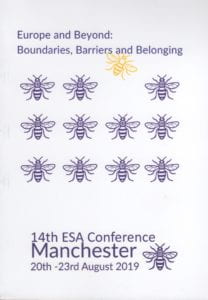
American Sociological Association’s Conference Flyer, 2019
At the American Sociological Association’s (ASA) conference in New York City (10-13 August 2019), she spoke on boundaries in art in a sole-authored paper entitled ‘Classification in Art, Revisited’. This paper was in one of three sessions on boundaries run by the Culture Section of the ASA.
Abstract
Current scholarship in the sociology of the arts tends to dichotomize the fine arts (still commonly referred to as high culture) and the popular arts (once referred to as mass culture), but with a recognition of the blurring of these two categories. DiMaggio (1987) theorized this dichotomy in his work on classification in art. However, focus on this division is problematic because it ignores a crucial similarity between the fine and popular arts, in that both are created and developed in (commercial or nonprofit) production systems for distribution to audiences who receive them. In other words, they separate production from consumption. This paper argues that it is problematic to overlook the division between producers and consumers. Indeed, other forms of artistic creativity, where production and consumption co-occur or blur, have been largely ignored in sociology and in studies of classification in art. Folk art, amateur art, and peer-production in digital spaces have not been effectively theorized as a contributing to classification (or declassification). A more complete theory of classification in art needs to consider the relationship between production and consumption, in systems where these are separated and those where they are not.

European Sociological Association’s Conference Programme Cover, 2019
The European Sociological Association’s (ESA) biennial conference was held closer to home this year, in Manchester (20-23 August 2019). Professor Alexander delivered a paper, co-authored with Anne Bowler, ‘Aesthetic Power and Aesthetic Fields: Theoretical and Conceptual Tools for Integrating the Work of Art into Sociological Analysis’.
Abstract
In 1987, Wendy Griswold discussed the importance of “aesthetic power” in sociological studies of art. She suggested that some works are more powerful than others, in their ability to link to “present and pressing” social concerns (p. 1104) and to sustain multiple coherent interpretations along with the capacity to “linger in the mind” and to “enter the canon” (p. 1105). More recently, Jeffrey Alexander (2008; 2012) has developed the concept of “iconicity” in a meaning-centred sociology. J. Alexander’s concept may at first brush seem similar to Griswold’s, but there are important differences. In this paper, we consider the notion of aesthetic power more fully, distinguishing it from iconicity, and integrating it into an aesthetically inflected sociology of art. We focus on a case study of a single work, a carved limestone sculpture entitled Boxer by the American artist William Edmondson (1874-1951). This sculpture is notable in that, in 2016, it set a new world-record price for Outsider art sold at auction and established a blue-chip auction market for the field. We analyse the elements of aesthetic power evident in the work and its reception. Our analysis also considers Edmondson’s canonization along with wider debates in the Outsider art world, which we characterize as an “aesthetic field.” We show that a consideration of the work of art itself is necessary for understanding the record-breaking sale of Boxer. This underscores the importance, more broadly, of attention to the work of art in arts sociology.
Both papers will be submitted for peer-review journal publication.